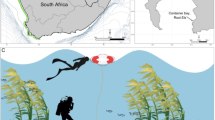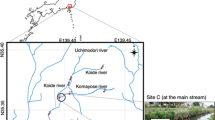Abstract
Habitat degradation and land-use change severely threaten the survival of fairy shrimp and the vernal pools in which they live. Limiting effective fairy shrimp conservation management efforts is the ability to readily identify species without the capture and sacrifice of individuals for microscopy. Here we demonstrate that eDNA metabarcoding is an effective non-invasive tool for monitoring fairy shrimp. Results from ten Southern California vernal pools comparing eDNA and traditional dip-net methods showed that eDNA metabarcoding with 16S rDNA provides exceptional species-level resolution. Importantly, while the two methods were concordant during early hydroperiods where adults were present, eDNA detected fairy shrimp for up to 2 months after dip-nets failed to detect any adults, expanding the time period for vernal pool monitoring. Together, these results provide resource managers a simple, cost-effective, and non-invasive method for biomonitoring endangered fairy shrimp species.


Similar content being viewed by others
Data availability
Sanger sequence 16S rDNA barcode data generated for this study has been submitted to the GenBank database under accession number. MN982235–MN982294. Supplemental Table 1 lists GenBank for all 16S rDNA sequences used in the study. Metabarcode generated sequencing data is available on dryad link: https://doi.org/10.5068/D1QD5M and https://doi.org/10.5068/D1DW95.
Code availability
Code used to analyze the data presented in this project are publicly available here: https://github.com/zjgold/Fairy-Shrimp-Metabarcoding.
References
Bauder ET, McMillan S (1998) Current distribution and historical extent of vernal pools in southern California and northern Baja California, Mexico. In: Witham CW, Bauder ET, Belk D et al (eds) Ecology, conservation and management of vernal pool ecosystems—proceedings from a 1996 conference. California Native Plant Society, Sacramento, pp 56–70
Bohmann K, Evans A, Gilbert MTP et al (2014) Environmental DNA for wildlife biology and biodiversity monitoring. Trends Ecol Evol 29:358–367. https://doi.org/10.1016/j.tree.2014.04.003
Chambert T, Pilliod DS, Goldberg CS et al (2018) An analytical framework for estimating aquatic species density from environmental DNA. Ecol Evol 8:3468–3477. https://doi.org/10.1002/ece3.3764
Curd EE, Gold Z, Kandlikar GS et al (2019) Anacapa Toolkit: an environmental DNA toolkit for processing multilocus metabarcode datasets. Methods Ecol Evol 10:1469–1475. https://doi.org/10.1111/2041-210X.13214
Davis NM, Proctor DM, Holmes SP et al (2018) Simple statistical identification and removal of contaminant sequences in marker-gene and metagenomics data. Microbiome 6:226. https://doi.org/10.1186/s40168-018-0605-2
Deiner K, Bik HM, Mächler E et al (2017) Environmental DNA metabarcoding: transforming how we survey animal and plant communities. Mol Ecol 26:5872–5895. https://doi.org/10.1111/mec.14350
Eng LL, Belk D, Eriksen CH (1990) Californian Anostraca: distribution, habitat, and status. J Crustac Biol 10:247–277. https://doi.org/10.2307/1548485
Eriksen CH, Belk D (1999) Fairy shrimps of California’s puddles, pools, and playas. Mad River Press, Eureka
Fremier AK, Strickler KM, Parzych J et al (2019) Stream transport and retention of environmental DNA pulse releases in relation to hydrogeomorphic scaling factors. Environ Sci Technol 53:6640–6649. https://doi.org/10.1021/acs.est.8b06829
Fugate M (1993) Branchinecta sandiegonensis, a new species of fairy shrimp (Crustacea: Anostraca) from western North America. Proc Biol Soc Wash 106:296–304
Goldberg CS, Turner CR, Deiner K et al (2016) Critical considerations for the application of environmental DNA methods to detect aquatic species. Methods Ecol Evol 7:1299–1307. https://doi.org/10.1111/2041-210X.12595
Hildrew AG (1985) A quantitative study of the life history of a fairy shrimp (Branchiopoda: Anostraca) in relation to the temporary nature of its habitat, a Kenyan rainpool. J Anim Ecol 54:99–110. https://doi.org/10.2307/4623
Keeley JE, Zedler PH (1998) Characterization and global distribution of vernal pools. In: Witham CW, Bauder ET, Belk D et al (eds) Ecology, conservation and management of vernal pool ecosystems—proceedings from a 1996 conference. California Native Plant Society, Sacramento, pp 1–14
Kelly RP, Gallego R, Jacobs-Palmer E (2018) The effect of tides on nearshore environmental DNA. PeerJ 6:e4521. https://doi.org/10.7717/peerj.4521
Kelly RP, O’Donnell JL, Lowell NC et al (2016) Genetic signatures of ecological diversity along an urbanization gradient. PeerJ 4:e2444. https://doi.org/10.7717/peerj.2444
King JL (1998) Loss of diversity as a consequence of habitat destruction in California vernal pools. In: Witham CW, Bauder ET, Belk D et al (eds) Ecology, conservation and management of vernal pool ecosystems—proceedings from a 1996 conference. California Native Plant Society, Sacramento, pp 119–123
Packard AS Jr (1883) A monograph of the Phyllopod Crustacea of North America, with remarks on the order Phyllocarida. Annu Rep US Geol Surv New Ser 12:295–516
Patel KV (2018) Genetic admixture in vernal pool shrimp: interspecific hybridization between Branchinecta sandiegonensis and Branchinecta lindahli. PhD thesis, University of California, Riverside
Patel KV, Simovich MA, Graige NS, Bohonak AJ (2018) A clash of characters: the effect of variation on a morphological hybrid index for an endangered California fairy shrimp Branchinecta sandiegonensis (Fugate, 1993) (Crustacea: Anostraca). J Crustac Biol 38:349–353. https://doi.org/10.1093/jcbiol/ruy014
Rogers DC (2002) Female-based characters for anostracan (Crustacea: Branchiopoda) identification: a key for species of California and Oregon, USA. Hydrobiologia 486:125–132. https://doi.org/10.1023/A:1021390416256
Simovich MA, Davis KA., Bohonak AJ (2013) Landscape homogenization threatens the genetic integrity of the endangered San Diego fairy shrimp Branchinecta sandiegonensis (Branchiopoda: Anostraca). J Crustac Biol 33:730–740. https://doi.org/10.1163/1937240X-00002164
The Chaparral Lands Conservancy, Rocks Biological Consulting (2017a) Proctor Valley ORV Site A Vernal Pool and Uplands Habitat Restoration Projects annual monitoring report—2017
The Chaparral Lands Conservancy, Rocks Biological Consulting (2017b) Otay Mesa Vernal Pool and Uplands Habitat Restoration Project annual monitoring report—2017
Thomsen PF, Willerslev E (2015) Environmental DNA—an emerging tool in conservation for monitoring past and present biodiversity. Biol Conserv 183:4–18. https://doi.org/10.1016/j.biocon.2014.11.019
US Fish and Wildlife Service (2007) Endangered and threatened wildlife and plants; designation of critical habitat for the San Diego fairy shrimp (Branchinecta sandiegonensis). Federal Regist 72(238):70648–70714
Wall AR, Campo D, Wetzer R (2014) Genetic utility of natural history museum specimens: endangered fairy shrimp (Branchiopoda, Anostraca). ZooKeys 457:1–14. https://doi.org/10.3897/zookeys.457.6822
Zacharias I, Zamparas M (2010) Mediterranean temporary ponds. A disappearing ecosystem. Biodivers Conserv 19:3827–3834. https://doi.org/10.1007/s10531-010-9933-7
Zedler JB (2003) Wetlands at your service: reducing impacts of agriculture at the watershed scale. Front Ecol Environ 1:65–72. https://doi.org/10.1890/1540-9295(2003)001[0065:WAYSRI]2.0.CO;2
Acknowledgements
We gratefully acknowledge David Hogon and The Chaparral Lands Conservancy for conserving the lands that made this research possible. We thank Rocks Biological Consulting, Inc. for collecting and preserving invertebrate samples used in this study. For help with field collections and invertebrate sample processing, sorting, and identifications, we thank colleagues Jenessa Wall and Kathy Omura at the Natural History Museum. We thank Benoit Goossens and the anonymous reviewer for their detailed and thoughtful input on this manuscript. We also thank Onny Marwayana, Taylor Ely, Keira Monuki, Markus Min, Bridget Foy, and McKenzie Koch for assistance with processing eDNA lab samples at UCLA. This publication is DISCO number 4 of the Diversity Initiative for the Southern California Ocean.
Funding
Support came from the University of California President’s Research Catalyst Award [CA-16-376437]. ZG was supported by the US-NSF Graduate Research Fellowship [DEG No. 1650604].
Author information
Authors and Affiliations
Contributions
Contributions could include, but are not limited to: Conceptualization ARW, ZG, NDP, RW, LR, PHB. Investigation ARW, ZG, EEC, RK. Funding Acquisition ARW, ZG, PHB, RW, NDP. Data Curation ARW, NDP, LR, RW, RK. Formal Analysis ARW, ZG, EEC, RK. Resources LR. Writing – Original Draft Preparation ARW, ZG, PHB, EEC, RK, LR, NDP, RW.
Corresponding author
Ethics declarations
Conflict of interest
No author has any conflicts of interest to report.
Ethics approval
No ethics approval was needed for this study. All samples were collected under USFWS permit TE-221290-4.
Consent to participate
No consent to participate was required for this study.
Consent for publication
All authors consent to the publication of this manuscript.
Additional information
Publisher's Note
Springer Nature remains neutral with regard to jurisdictional claims in published maps and institutional affiliations.
Electronic supplementary material
Below is the link to the electronic supplementary material.
Rights and permissions
About this article
Cite this article
Gold, Z., Wall, A.R., Curd, E.E. et al. eDNA metabarcoding bioassessment of endangered fairy shrimp (Branchinecta spp.). Conservation Genet Resour 12, 685–690 (2020). https://doi.org/10.1007/s12686-020-01161-9
Received:
Accepted:
Published:
Issue Date:
DOI: https://doi.org/10.1007/s12686-020-01161-9




